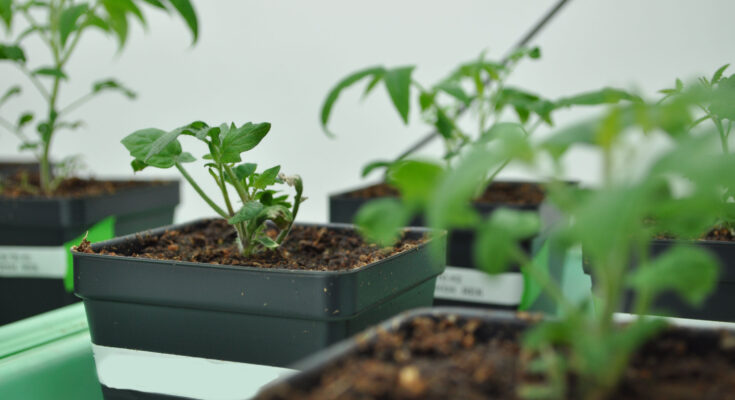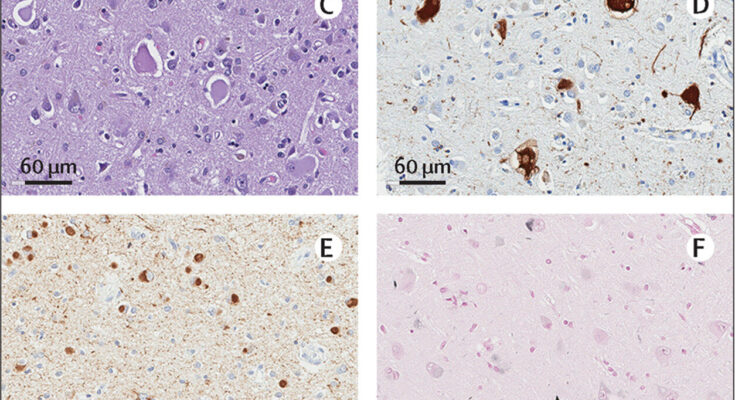× shut up
In Michigan State’s Department of Biochemistry and Molecular Biology, tomato seeds are grown for final lab research on the Solanaceae plant family, also known as nightshades. The researchers analyzed the unique chemical differences between the roots and the shoots, both of which contain acylsugars. Credit: Connor Yeck/MSU
In a paper appearing on Advances in ScienceMichigan State University researchers have uncovered a mysterious genetic secret based on the sugar found in what gardeners know as “tomato tar.”
Anyone who has pruned tomato plants with bare hands may find their fingers dark with a sticky, black-gold substance that won’t wash off. This tomato sauce is sticky for good reason. It is made of sugars – acylsugars, to be precise – and acts as a kind of natural flying paper for pests.
“Plants have evolved to make a surprising number of toxins and other biological compounds,” said Michigan State researcher Robert Last, lead author of the new study.
The latter lab specializes in acylsugars and the tiny, hair-like structures where they are produced and stored, known as trichomes. Once thought to be found only in trichomes, other researchers have recently reported finding acylsugars in tomato roots as well. This came as a surprise to the plant science community.
In their study, the Michigan State University team wanted to learn how root acylsugars work and where they come from. They found that tomato plants not only make chemically unique acylsugars in their roots and trichomes, but these acylsugars are produced through two identical metabolic pathways.
This is the equivalent of assembly lines in a car factory making two different models of the same car, but they never work together.
The discoveries help scientists better understand the story of the persistence and evolution of the Solanaceae, or nightshades, a diverse family of plants that includes tomatoes, eggplants, potatoes, peppers, tobacco and petunias. They can also help inform researchers who want to develop molecules made by plants into compounds to help people.
“From medicines, to pesticides, to sunscreens, many of the small molecules that humans have adapted for different uses come from an arms race between plants, microbes and insects. ,” said Last.
Roots and shoots
In addition to chemicals important for growth, plants also produce a wealth of compounds that play an important role in ecological relationships. These can attract good bacteria and are the first line of defense against harmful bacteria.
“What’s amazing about these unique metabolites is that they’re often made in very precise cells and tissues,” said Rachel Kerwin, a postdoctoral researcher at MSU and first author of the latest paper.
“Take acylsugars, for example. You won’t find them produced in the leaves or stems of the tomato plant. These protective metabolites that attach to the body are made right at the tip of the trichomes.”
When it was reported that acylsugars could also be found in tomato roots, Kerwin took it as a call to action from earlier genetic work.
“The presence of acylsugars in roots was surprising and led to many questions. How did this happen, how is it made and how is it different from the trichome acylsugars we have been studying?”
To begin tackling the evolutionary problem, lab members collaborated with experts from MSU’s Mass Spectrometry and Metabolomics Core, as well as staff at the Max T. Rogers Nuclear Magnetic Resonance Center.
When comparing metabolites from the roots of tomato seedlings and shoots, different differences emerged. The basic chemical structures of terrestrial and terrestrial acylsugars were so different that they could be classified as completely different groups of acylsugars.
Car wreck
Finally, the Distinguished Professor of the University of the College of Natural Sciences in the Department of Biochemistry and Molecular Biology and the Department of Plant Biology, provides a useful analogy to explain how a geneticist deals with biology.
He said: “Imagine trying to figure out how a car works by breaking one part at a time. “If you flatten the car’s tires and notice that the engine is still running, you find out the important truth even if you don’t know what the tires do exactly.” Change the parts of the car for genetics, and get a clear picture of the work accomplished by the last Lab to continue to destroy code in root acylsugars.
Looking at the genome sequence data, Kerwin realized that many of the genes implicated in tomato trichome acylsugar production have close relatives in the root. After identifying the enzyme believed to be the first step in acylsugar biosynthesis, the researchers began to “break the car.”
× shut up
Left to right: Jaynee Hart, Rachel Kerwin and Robert Last stand in front of the Mass Spectrometry and Metabolomics Core analytical equipment at Michigan State University. A team of researchers unraveled the mystery of evolution and genetics in tomato plants. Credit: Connor Yeck/MSU
When they removed the root type of acylsugar, acylsugar production disappeared, leaving trichome acylsugar production unaffected. Meanwhile, when the well-studied trichome acylsugar was removed, root acylsugar production continued as normal.
These studies have provided compelling evidence for the suspected existence of a metabolic mirror.
“Next to the surface acylsugar pathway that we’ve been studying for years, here we find a second parallel universe that exists underground,” said Last.
“This ensured that we had two routes in one plant,” Kerwin added.
To drive this success, Jaynee Hart, a postdoctoral researcher and second author on the latest paper, looked closely at the activities of trichome and root enzymes. As trichome enzymes and the acylsugars they produce are a well-studied chemical compound, he found a promising link between root enzymes and root acylsugars.
“Studying specific enzymes is a powerful tool for validating their activity and drawing conclusions about their functional role within the plant cell,” Hart explained.
These findings were further evidence of similar metabolic pathways in the same tomato plant.
“Plants and cars are very different, yet they are similar in that when you open the proverbial hood you realize the multitude of parts and relationships that make them work. to research its evolution and its function and that can we use it in other ways,” said Pankaj Jaiswal, program director at the US National Science Foundation.
He added: “The more we learn about living things—from tomatoes and other crops, to animals and microbes—the greater the opportunity to use that knowledge for the good of the community.
Groups within groups
The paper also reports a surprising and unexpected change involving the biosynthetic gene clusters, or BGCs. BGCs are a collection of genes that are physically organized on a chromosome and participate in a specific metabolic process.
Previously, the latter lab identified a BGC containing genes related to trichome acylsugars in tomato plants. Kerwin, Hart, and their colleagues have now discovered that the acylsugar enzyme produced by roots resides in the same group.
“Often in BGCs, the genes are expressed in the same cells and under the same conditions,” Kerwin said.
“But here, we have two separate but linked sets of genes. Some are expressed in trichomes, and some are expressed in roots.”
This revelation led Kerwin to delve into the evolution of Solanaceae species, hoping to determine when these two unique acylsugar pathways arose.
In particular, researchers focused on a moment about 19 million years ago when the enzyme responsible for trichome acylsugars was duplicated. This enzyme will one day be responsible for the newly discovered acylsugar pathway produced by roots.
The exact mechanism that “turned on” this enzyme in the roots is still unknown, paving the way for the last lab to continue to reveal the evolutionary and metabolic secrets of the nightshade family.
“Working with Solanaceae provides many scientific resources, as well as a strong community of researchers,” said Kerwin. “With their importance as crops and horticulture, these are plants that people have cared for for thousands of years.”
Finally, these developments are also a reminder of the importance of natural pesticides, which protective metabolites such as acylsugars ultimately represent.
“If we find that these root acylsugars are effective in repelling harmful pathogens, can they be added to other nightshades, thus helping the plants to grow without the need for harmful synthetic fungicides? and pesticides?” He ended up asking.
“These are the central questions of people’s pursuit of clean water, safe food and reducing dependence on harmful synthetic chemicals.”
Additional information:
Rachel Kerwin et al, tomato root-specific metabolites evolved through gene duplication and regulatory segregation within a cluster of biosynthetic genes, Advances in Science (2024). DOI: 10.1126/sciadv.adn3991. www.science.org/doi/10.1126/sciadv.adn3991
Newspaper articles:
Advances in Science
#Researchers #discover #universal #parallels #tomato #genes






